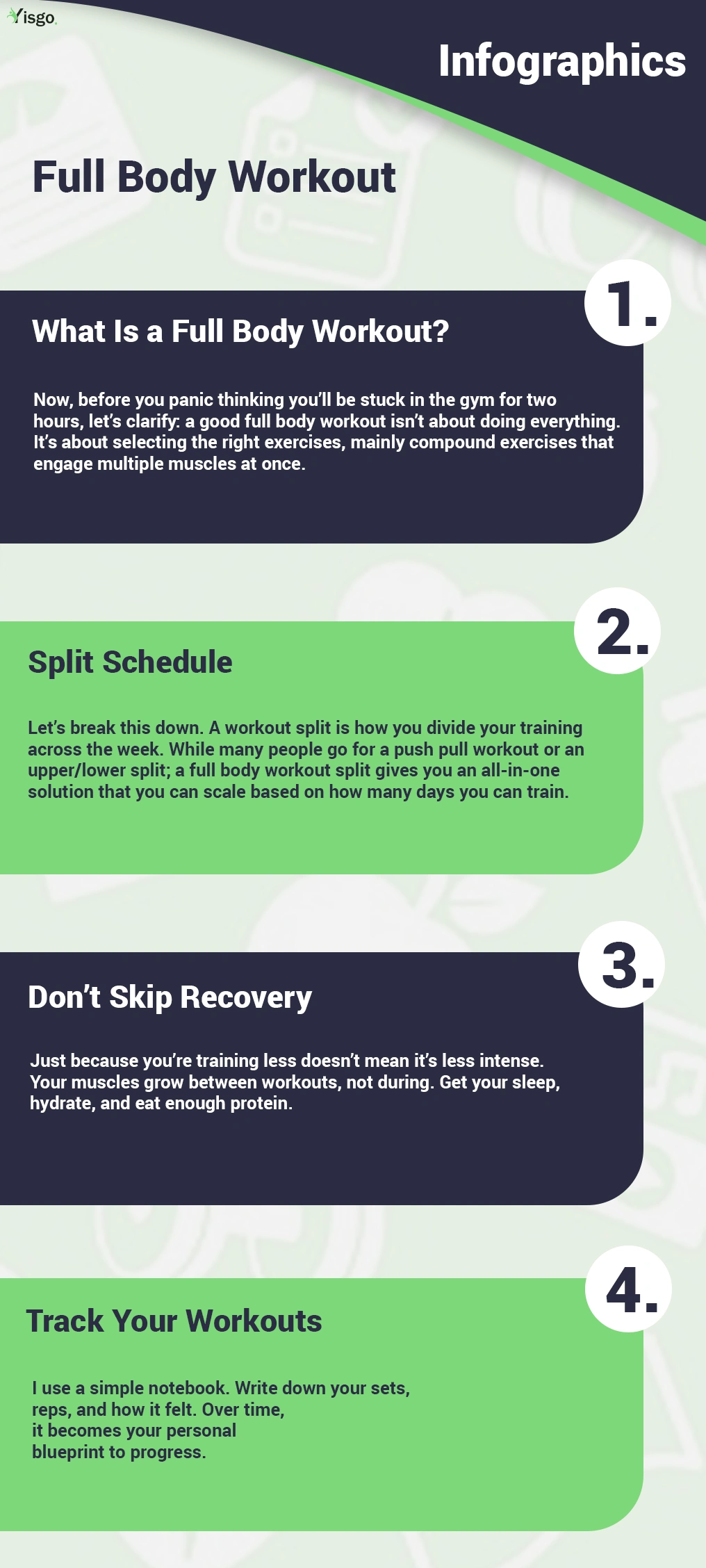With ultimate honesty, most of us have been the kind of people who walked into the gym, glanced around, and hopped on whatever machine was free. Just to make ourselves feel that we are “doing something,” but we have always neglected real results. Sounds correct to you too, right? That would be the case until we learn about the power of a full body workout and how to plan a proper routine split schedule around it.
If you’re starting out or just want to maximize your time in the gym, this is one of the smartest ways to train.
And trust us, it’s not just for beginners, but for some of the pros as well. Let’s get into what a full body workout routine really means, how it works, and how you can build your own effective split schedule.
What Is a Full Body Workout?
At its core, a full body workout is a routine that targets all your major muscle groups in one session, we’re talking chest, back, legs, arms, and core, etc. all in one go.
Now, before you panic thinking you’ll be stuck in the gym for two hours, let’s clarify: a good full body workout isn’t about doing everything. It’s about selecting the right exercises, mainly compound exercises that engage multiple muscles at once.

Visit: Deadlifts: Should It Be on Leg Day or Back Day?
Think less about isolating your biceps and more about doing movements like squats, Romanian deadlifts, and seated cable rows that give you more bang for your buck uhm, value for money.
Why Choose a Full Body Workout Routine?
Here’s the deal: not everyone has five or six days a week to train. That’s where full body workouts shine. With just 2 to 4 sessions a week, you can see real results without living in the gym.
Plus, full body routines are:
- Time-efficient
- Easy to follow
- Perfect for beginners
- Great for fat loss and building strength
- Flexible with rest days
It’s also the best way to build a beginner workout plan that doesn’t overwhelm you with too many moving parts. You learn foundational lifts, build strength, and give your body time to recover.
How a Full Body Workout Fits Into a Split Schedule
Let’s break this down. A workout split is how you divide your training across the week. While many people go for a push pull workout or an upper/lower split; a full body workout split gives you an all-in-one solution that you can scale based on how many days you can train.
Here’s the key: quality over quantity. You don’t need to train every day, you need to train smart.
2, 3, or 4 Day Full Body Workout Split: What Works for You?
2-Day Full Body Split (Ideal for Super Busy Schedules)
If you only have two days a week, you can still build strength and muscle.
Example Split:
- Tuesday: Full Body Workout A
- Friday: Full Body Workout B
This leaves you plenty of time to rest or add light cardio on off days. Stick to compound exercises and train hard. That’s how you make progress.

3-Day Full Body Split (My Favorite Option)
Perfect balance of work and recovery. You’ll hit every muscle group three times a week; enough to see noticeable gains.
Example Split:
- Monday: Workout A
- Wednesday: Workout B
- Friday: Workout C
Use different variations across the week to target muscles slightly differently while still hitting the basics.
Discover: Leg Press vs Hack Squats: Which Is Best for Your Fitness Goals?
4-Day Workout Split (For Those Who Want More)
Yes, you can do a 4 day workout split with a full body focus, but this version often includes one or two “light” days to reduce fatigue.
Example Split:
- Monday: Heavy Full Body
- Tuesday: Light Full Body or Cardio
- Thursday: Moderate Full Body
- Saturday: Accessory / Conditioning
This type of routine is especially useful if you’re starting to build muscle and want a bit more intensity.
Building the Full Body Workout Routine
Alright, now for the fun part, what exactly goes into a good full body workout routine?
I always build mine around compound lifts, then sprinkle in a few accessory movements for balance.

Day A: Strength Foundation
- Squats – 4 sets of 6
- Bench Press – 3 sets of 8
- Bent Over Rows – 3 sets of 10
- Planks – 3 x 30 seconds
- Triceps Pushdowns – 2 sets of 12
Explore: Irresistible Chilli Chicken Recipe | Quick and Spicy Delight
Day B: Posterior Chain Focus
- Romanian Deadlifts – 4 sets of 8
- Pull-ups or Assisted Pull-ups – 3 sets to failure
- Dumbbell Lunges – 3 sets of 10 (each leg)
- Overhead Press – 3 sets of 8
- Hanging Leg Raises – 3 sets of 12
Day C: Functional and Isolation Mix
- Deadlifts – 4 sets of 5
- Push-ups or Incline Dumbbell Press – 3 sets of 10
- Seated Cable Rows – 3 sets of 12
- Cable Face Pulls – 3 sets of 15
- Russian Twists – 3 sets of 20 (10 each side)
Keep your rest periods around 60–90 seconds. Focus on form over weight. If your form breaks down, you’re probably lifting too heavy.
Tips to Maximize Your Full Body Split
Here’s some advice I wish someone gave me when I started:
1. Progressive Overload Is Key
Try to lift a little heavier, do one more rep, or add a set each week. This is what actually builds muscle.
2. Don’t Skip Recovery
Just because you’re training less doesn’t mean it’s less intense. Your muscles grow between workouts, not during. Get your sleep, hydrate, and eat enough protein.
3. Track Your Workouts
I use a simple notebook. Write down your sets, reps, and how it felt. Over time, it becomes your personal blueprint to progress.
4. Warm-Up and Cool Down Matter
A few minutes of dynamic stretching or light cardio before and after makes a massive difference in how you feel.
Common Mistakes People Make With Full Body Workouts
Even though it sounds simple, I’ve seen people mess up a full body workout routine by:
- Doing too many isolation moves
- Not resting between sets
- Ignoring proper form
- Not progressing weights
- Training five days a week with no recovery
Remember, this type of training works best when you train hard, recover well, and stay consistent.
Learn More: Creamy Chicken Pasta: Quick & Flavorful Weeknight Recipe
Full Body vs Push Pull Workout
You might be wondering, why not just go with a push pull workout?
Well, push pull splits are awesome for intermediate to advanced lifters. But for beginners or anyone tight on time, full body routines make more sense. You train everything, more frequently, and don’t need to memorize a complex plan.
That said, once you’ve nailed your full body plan, shifting into a push pull workout or even an upper-lower split can be a great next step.
Keep It Simple, Stay Consistent
The best workout is the one you’ll actually stick to. I started seeing real results when I stopped overthinking and started doing the basics consistently.
A full body workout routine, whether you go for a 2, 3, or 4 day split, is a solid choice. Especially if you’re busy, new to strength training, or just want a plan that works without burning you out.
Start small. Keep the routine realistic. Focus on compound exercises like Romanian deadlifts, squats, presses, and rows. And don’t forget to rest. Your body will thank you.
So, next time you walk into the gym, don’t wing it. Go in with a full body workout split that fits your life and fuels your goals.
Train smart. Keep showing up. And enjoy the gains.
